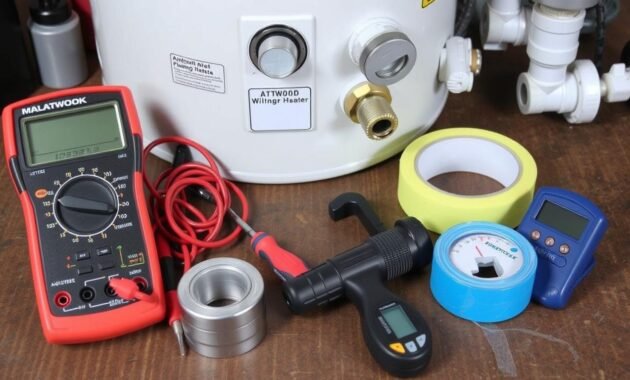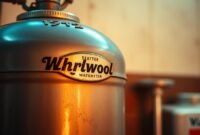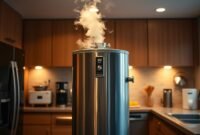Are you tired of your Atwood water heater acting up? RV owners often deal with weird problems that ruin their trips. Issues like leaks, ignition failures, and temperature problems can leave you feeling cold and worried.

I’ve been figuring out these tough issues for years. My guide will show you how to spot, understand, and fix common problems. Whether it’s electronic ignition issues or pressure valve problems, I’ll help you fix your RV’s hot water system.
Read also: Hot Water Heater Smells Like Gas
Understanding Your Atwood 6 Gallon Water Heater
The Atwood 6-gallon water heater is a top choice for RV owners. It’s compact and efficient, perfect for travel. Its design is unique, unlike home water heaters.
Let’s explore what makes these water heaters easy to maintain. This knowledge helps RV owners fix issues quickly.
Basic Components and Features
- Lightweight aluminum tank design
- 12VDC electrical system
- Direct spark ignition mechanism
- Pre-set thermostat at 140°F
- Multiple integrated safety features
Technical Specifications
| Specification | Details |
|---|---|
| Tank Capacity | 6 Gallons |
| Power Source | 12VDC/LP Gas |
| Tank Lining | Clad Aluminum |
| Ignition Type | Direct Spark |
Operating Principles
The water heater’s direct spark ignition system helps avoid pilot light issues. It has an ON/OFF switch, thermal cut-off, thermostat, and circuit board. This setup ensures it works well on the road.
Atwood water heaters have an aluminum tank, so you don’t need to replace the anode rod every year. Most maintenance can be done from the outside. Only the 110 VAC heating parts need inside access.
Regular maintenance is key to avoiding pilot light problems. It keeps your water heater running smoothly. Always check and monitor your RV water heater to prevent issues on your travels.
Essential Tools and Equipment for Troubleshooting

When you face issues with a 6-gallon heater, the right tools are key. They help you find and fix problems fast. Most Atwood water heater repairs can be done from outside, so a good toolkit is essential.
To tackle a leaking water heater or a thermostat that won’t work, you’ll need special tools:
- U-Tube Manometer for precise gas pressure measurement
- Multi-meter for electrical continuity testing
- Circuit Board Tester for advanced diagnostics
- Leak test solution for detecting gas leaks
Atwood suggests a set of hand tools for thorough troubleshooting:
- 1/8″ and 1/4″ nut drivers
- Open-end wrenches
- Flat blade screwdrivers
- Phillips head screwdrivers
Don’t forget a 12VDC battery or a filtered converter for voltage tests. With over 700 service centers in the U.S., Atwood offers a lot of support. But, having these tools can help you solve common water heater issues quickly.
Common Ignition Problems and Solutions
Dealing with water heater issues in RVs can be tough. Ignition problems are a big concern. They can mess up your comfort and hot water. Knowing these common issues can help you fix them fast.
Pilot Light Issues
Pilot light problems are common in Atwood water heaters. Several things can cause these issues:
- Dirty or misaligned pilot assembly
- Blocked burner tube
- Weak thermocouple connection
- Gas supply interruptions
Electronic Ignition Failures
Modern Atwood water heaters have electronic ignition. This can fail for many reasons:
- Loose high-tension lead wires
- Incorrect electrode gapping
- Dirty or corroded electrodes
- Defective circuit board
Gas Supply Problems
Gas supply issues can stop your water heater from working. Here’s a guide for common gas problems:
| Problem | Potential Cause | Recommended Action |
|---|---|---|
| Low gas pressure | Regulator malfunction | Check and replace gas regulator |
| Blocked orifice | Debris or corrosion | Clean or replace burner orifice |
| Incorrect gas mixture | Improper propane settings | Adjust gas mixture or consult professional |
For complex problems, getting help from a pro might be best. Always be careful when fixing your Atwood water heater.
Read also: Why and How to Convert Gas Water Heater to Electric ?
Temperature Control and Thermostat Issues

Understanding temperature control in Atwood water heaters is key for good maintenance. Most 6-gallon models are set to 140°F by default. This can sometimes lead to heating issues.
Thermostat problems can show up in different ways. You might find water too hot or not hot enough. This suggests a problem with the temperature control system.
- Preset temperature limitation at 140°F
- Potential thermostat malfunction
- Solenoid valve control problems
- Emergency Cut Off (ECO) sensor failures
To fix temperature issues with your Atwood heater, follow some diagnostic steps. First, check the thermostat connections. Then, look at the emergency shutoff mechanisms.
| Symptom | Potential Cause | Recommended Action |
|---|---|---|
| Water too hot | Faulty thermostat | Replace thermostat kit |
| No hot water | ECO sensor failure | Check electrical connections |
| Inconsistent temperature | Solenoid valve issue | Inspect and potentially replace valve |
Consider the optional Atwood adjustable thermostat (part #93105) for better control. Replacing it is easy and can be done in about 20 minutes. Just make sure to follow safety guidelines.
Most Atwood water heater repairs can be done by yourself. This includes fixing temperature control issues. So, if you’re confident in your DIY skills, you can tackle these repairs yourself.
Water Pressure and Leakage Problems
When your heater isn’t working right, water heater leaks can be a big problem for RV owners. It’s important to know why these leaks happen. This helps keep your Atwood 6-gallon water heater working well and avoids expensive fixes.
Identifying Leak Sources
Leaks can come from different places. Here are the main spots to check:
- Connection points around valves
- Pressure relief valve openings
- Tank body seams
- Pipe connections
Pressure Relief Valve Issues
The pressure relief valve is key to stopping too much pressure. If it fails, it can cause leaks and dangerous situations.
| Symptom | Potential Cause | Recommended Action |
|---|---|---|
| Constant dripping | Valve malfunction | Replace pressure relief valve |
| Water discharge | Excessive system pressure | Check system pressure settings |
Tank Corrosion Signs
Even with a protective lining, Atwood water heaters can corrode. Look out for these signs:
- Rust-colored water
- Visible rust spots on tank exterior
- Recurring leaks near tank bottom
- Unusual odors in hot water
Regular checks and upkeep can stop pilot light problems and find water heater issues early. Being proactive keeps your RV’s water heating system running smoothly and efficiently.
Electrical System Diagnostics
Electrical system problems can really hurt your Atwood water heater’s performance. It’s key to know how to find these issues to keep your heater working well and avoid big problems.
When you’re trying to fix heater temperature issues, start by checking the electrical parts. Make sure they’re working right.
- Verify power supply voltage
- Test control board connections
- Inspect electrical switches and relays
- Check thermal cut-off fuse
To fix electrical issues in your Atwood heater, you’ll need some basic tools:
- Digital multimeter
- Wire strippers
- Voltage tester
- Protective electrical gloves
Looking at your atwood heater manual is very important. It helps you understand how to do the right tests. Always check the voltage needs before you start any electrical tests.
| Electrical Component | Typical Voltage Range | Common Diagnostic Test |
|---|---|---|
| Control Board | 12VDC | Continuity Test |
| Heating Element | 115VAC | Resistance Measurement |
| Thermal Cut-off | 24VDC | Voltage Verification |
Remember, safety is the most important thing when you’re doing electrical tests. Always turn off the power before you start. And don’t forget to wear the right safety gear.
Gas System Troubleshooting
Understanding your Atwood water heater’s gas system is key. Proper troubleshooting helps avoid failures and keeps your system running well.
Gas Pressure Testing Techniques
Gas pressure is vital for your Atwood water heater. Here’s what to check:
- Minimum gas pressure should be 11″ W.C. with multiple appliances running
- Use a manometer for accurate pressure measurements
- Verify gas supply consistency
Valve Inspection Methods
Valve inspections are critical, as per my atwood troubleshooting guide. Focus on these areas:
- Check solenoid valve alignment
- Inspect for proper electrical connections
- Verify valve opening and closing mechanism
| Inspection Point | Expected Condition | Action |
|---|---|---|
| Solenoid Valve | Proper Alignment | Adjust if misaligned |
| Electrical Connections | Secure and Clean | Tighten and Clean Connections |
| Voltage Reading | 12.29 DC Volts | Confirm Electrical Integrity |
Burner Maintenance Best Practices
Keeping your burner in good shape is vital. Here are some tips:
- Clean burner tube regularly
- Adjust air shutter to approximately 1/4 open
- Align flame spreader carefully
- Check for any debris or blockages
By following these steps, your Atwood water heater will run efficiently and reliably.
Maintenance and Prevention Tips
To keep your Atwood water heater in great shape, you need to take care of it regularly. Doing so can make your unit last longer and save you from expensive fixes.
Here are some key atwood maintenance tips to help your water heater work well:
- Flush the water heater system twice annually to remove mineral buildup
- Inspect electrical connections for signs of wear or corrosion
- Clean burner components to prevent debris accumulation
- Check pressure relief valve functionality
- Perform winterization to protect against freeze damage
Fixing water heater problems is easier when you maintain it well. Most issues (95%) are with the outside parts. So, it’s important to check them often.
| Maintenance Task | Frequency | Purpose |
|---|---|---|
| System Flush | Twice per Year | Remove Mineral Deposits |
| Electrical Connection Check | 1-2 Times Yearly | Prevent Electrical Issues |
| Burner Cleaning | Every 6 Months | Ensure Efficient Operation |
Atwood water heaters come in 6 and 10-gallon sizes. Each needs special care. Always check your manual for how to keep your model in good shape.
By following these maintenance tips, you’ll make your RV water heater last longer. This means fewer surprises and no need for costly new ones.
Conclusion
Dealing with an Atwood water heater can seem tough. I’ve shown you how to find and fix common problems with your 6-gallon water heater. Knowing how your RV water heater works is key to keeping it running well.
Working with the Atwood 6 Gallon Water Heater, I learned that most issues can be fixed with the right steps. Checking electrical and gas systems is important. The atwood troubleshooting guide I shared helps keep your water heater in top shape.
When it comes to RV water systems, safety is always first. While fixing things yourself can save money, some jobs need a pro. If you’re not sure about a repair, it’s best to call a certified RV technician. A well-kept water heater means comfortable travels without stress.
Your Atwood water heater is vital for your RV’s comfort. By using the troubleshooting and maintenance tips from this guide, you’ll make your 6-gallon water heater last longer. And you’ll have hot water for all your adventures.


